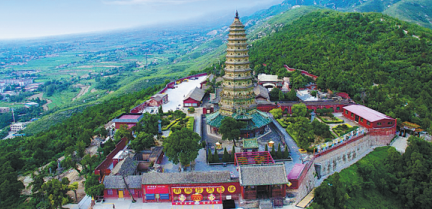Temple hosts precious art and religious relics

Feihong Pagoda in Guangsheng Temple is one of five pagodas in China that house the sarira of the Buddha. [Photo by Wang Yongqiang for China Daily]
When mentioning Hongtong county in Shanxi province, many people think about the township of Dahuaishu. It is believed by many Chinese to be their ancestral hometown as a result of mass migration during the Ming Dynasty (1368-1644).
But there is at least one other destination in the county with a similar cultural significance, especially for tourists and researchers interested in Buddhism, ancient architecture and the arts.
It is Guangsheng Temple in the northeast of Hongtong. Located 17 kilometers to the northeast of the county seat, Guangsheng Temple was built in 147 during the Eastern Han Dynasty (25-220). The majority of its main structures were damaged in an earthquake during the Yuan Dynasty (1271-1368). It was rebuilt throughout the Ming and Qing (1644-1911) dynasties.
Guangsheng is a temple complex consisting of three main parts: the upper temple, the lower temple and the Water God Temple.
The most spectacular structure is the 13-storey Feihong Pagoda in the upper temple, which stands on the top of Huoshan Mountain.
Feihong means flying rainbow in Chinese. It is so named because of its roofs glazed in seven colors.
The pagoda's significance to Buddhists and researchers is that it is among the five pagodas in China that house the sarira of the Buddha.
Sarira are remains from the cremation of the Buddha or the body of a saintly monk. Often shaped like beads, they are regarded as the most treasured Buddhist relics.
After Sakyamuni, the founder of Buddhism, was cremated some 2,500 years ago, a few pieces of his sarira were brought to China by monks preaching Buddhism.
Also of similar cultural value are 13 wall paintings in the main hall of the Water God Temple.
Covering a total area of 197 square meters, the paintings are believed by researchers to have been created during the Yuan Dynasty. They portray life of the period, with topics covering the ritual of praying for rain, making medicine, selling fish and the lives of the royal family.
The most precious among the paintings is the one depicting an opera performance in the Yuan Dynasty. There is a complete presentation of all the typical roles, featuring young and old men, as well as women and comedians, along with a whole set of musical instruments.
Researchers said the costumes and makeup of such roles are still used on the stage today.
The Yuan Dynasty opera represented the first peak of China's theatrical art, with a number of masterpieces still preserved to this date.
Peng Ke'er contributed to this story.



